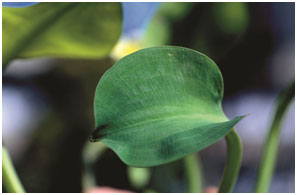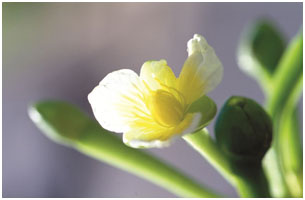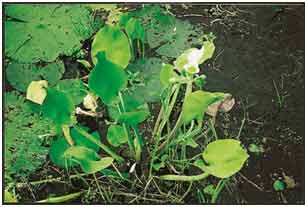Limnocharis flava
What to look for
An aquatic weed that grows to about one metre in height with pale green oval leaves and yellow flowers, each with three petals and numerous bright yellow stamens.
What you can do
- Do not move plants, plant material or soil out of the Torres Strait Protected Zone to the Torres Strait Permanent Biosecurity Monitoring Zone, or from either zone to mainland Australia without a permit and an inspection by a departmental biosecurity officer.
- Report any signs of suspect exotic weeds to the department by phone on +61 7 4241 7800 or email NAQS.

Profile
Limnocharis is a serious weed of shallow ponds, wetlands and slow moving streams. Dense infestations can choke dams and irrigation canals and destroy freshwater ecosystems. Once established, limnocharis spreads rapidly through massive seed production and vegetative propagation. Although plants usually grow rooted in a muddy substrate, small plantlets can be carried long distances in floodwaters. Unusual leaves and attractive flowers have led to this plant being cultivated in water features.

Long triangular stalks are a distinctive feature
Identification
Limnocharis is a clumped perennial herb growing to heights of about 1 metre. Leaves are pale green with oval blades. Flower heads are borne at the apex of long triangular stalks. Each flower has three pale yellow petals with numerous bright yellow stamens. The segmented fruit contains large numbers of tiny brown seeds that travel long distances in water. New shoots form from the centre of each flower head. All parts of the plant contain a milky sap.
Distribution
Originally from tropical America, limnocharis is now a troublesome weed in Sri Lanka, India, Thailand, Malaysia and Indonesia. It is also spreading in Papua New Guinea. Several infestations discovered in the region between Cairns and Townsville in Queensland have necessitated active control measures.

The flowers have pale yellow petals
Threat
Farm dams, freshwater ecosystems and the growing aquaculture industry in northern Australia are vulnerable to incursion of limnocharis. With a rapid reproductive rate and waterborne seeds, limnocharis would be difficult and costly to control if it established widely.
Keep a Top Watch!
Water is one of Australia’s most precious natural resources. It is vital that we prevent new weeds from invading rivers, reservoirs and wetlands. Limnocharis may also be found in ornamental ponds. If you think you have seen this weed, please call the department.

The weed infests rivers and wetlands
Report any unusual water plants that you don’t recognise.
